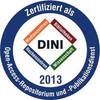German Title: Aspekte von Tensormodellen und Tensorfeldtheorien
Preview |
PDF, English
- main document
Download (6MB) | Lizenz:  Creative Commons Attribution 4.0 Creative Commons Attribution 4.0
|
Abstract
This thesis investigates random tensor models and their applications across quantum field theory. Originating in quantum gravity studies, tensor models provide a framework for generating discrete random geometries and have connections to several other fields, including topology, conformal field theory, and constructive field theory. Their extension to d-dimensional quantum field theories constitutes tensor field theories. The most important feature of tensor models is their melonic large N limit. The 1/N expansion allows for non-trivial and systematic resummations of correlation functions, making them interesting quantum field theory models. Other methods that are used in this thesis include combinatorics, asymptotic series analysis, and two-particle irreducible effective action techniques. Three main themes are developed throughout this work. First, the research on tensor models with symplectic symmetry broadens our understanding of tensor models with various symmetry groups. We establish a formal relation between orthogonal and symplectic random tensor models, demonstrating that tensor models with O(N) symmetry are related to corresponding models with Sp(N) symmetry through the replacement N to -N. This duality extends to tensors transforming in arbitrary finite-dimensional representations of these groups and provides a framework for new fermionic models. Second, we analyze the zero-dimensional O(N ) vector model using constructive field theory techniques, particularly the Loop Vertex Expansion, establishing analyticity and Borel summability properties of the free energy. We derive transseries expansions that incorporate both perturbative and non-perturbative contributions. Third, we study a four-dimensional O(N)³ tensor field theory exhibiting asymptotic freedom in the ultraviolet while developing strong correlations in the infrared. Through numerical solution of the Schwinger–Dyson equations, we demonstrate how quantum fluctuations significantly modify the propagator and identify a threshold mass below which the running coupling diverges at a finite infrared scale.
Translation of abstract (German)
Diese Dissertation untersucht Zufallstensoren und ihre Anwendungen in der Quantenfeldtheorie. Die Ursprünge der Zufallstensoren liegen in der Erforschung der Quantengravitation und bieten einen Ansatz zur Erzeugung diskreter Zufallsgeometrien mit Verknüpfungen zu verschiedenen anderen Fachrichtungen wie der Topologie, der konformen Feldtheorie und der konstruktiven Feldtheorie. Ihre Erweiterung auf d-dimensionale Quantenfeldtheorien führt zu Tensorfeldtheorien. Die wichtigste Eigenschaft von Tensormodellen ist ihr melonisches Large N-Limit. Die 1/N -Entwicklung ermöglicht eine nicht triviale und systematische Resummierung von Korrelationsfunktionen, was diese Modelle zu interessanten Feldtheorien macht. Weitere in dieser Arbeit verwendete Methoden umfassen Kombinatorik, die Analyse asymptotischer Reihen und die Methode der Zwei-Teilchen-irreduziblen effektiven Wirkung. Diese Arbeit verfolgt drei Hauptthemen. Erstens erweitert die Forschung über Tensormodelle mit symplektischer Symmetrie unser Verständnis von Tensormodellen mit unterschiedlichen Symmetriegruppen. Wir stellen eine formale Beziehung zwischen orthogonalen und symplektischen Zufallstensoren her und zeigen, dass Tensormodelle mit O(N)-Symmetrie mit entsprechenden Modellen mit Sp(N)-Symmetrie durch die Substitution von N zu -N in Beziehung stehen. Diese Dualität erstreckt sich auf Tensoren in beliebigen endlichdimensionalen Darstellungen dieser Gruppen und bietet einen methodischen Rahmen für neue fermionische Modelle. Zweitens analysieren wir das nulldimensionale O(N )-Vektormodell mit Techniken der konstruktiven Feldtheorie, insbesondere der Loop Vertex Expansion, und zeigen Analytizitäts- und Borel-Summierbarkeitseigenschaften der freien Energie. Wir leiten Transreihenentwicklungen her, die sowohl perturbative als auch nicht perturbative Beiträge einbeziehen. Drittens untersuchen wir eine vierdimensionale O(N)³-Tensorfeldtheorie, die asymptotisch frei im Ultravioletten ist und starke Korrelationen im Infraroten entwickelt. Durch numerisches Lösen der Schwinger–Dyson-Gleichungen zeigen wir, wie Quantenfluktuationen den Propagator signifikant modifizieren und identifizieren eine Grenzmasse, unterhalb derer die laufende Kopplung bei einer endlichen Infrarotskala divergiert.
| Document type: | Dissertation |
|---|---|
| Supervisor: | Gurǎu, Prof. Dr. Rǎzvan |
| Place of Publication: | Heidelberg |
| Date of thesis defense: | 23 July 2025 |
| Date Deposited: | 29 Jul 2025 13:24 |
| Date: | 2025 |
| Faculties / Institutes: | The Faculty of Physics and Astronomy > Institute for Theoretical Physics Service facilities > Interne wissenschaftliche Verbünde > Excellence cluster "STRUCTURES: Emergence in nature, mathmatics and complex data" |
| DDC-classification: | 500 Natural sciences and mathematics 510 Mathematics 530 Physics |









